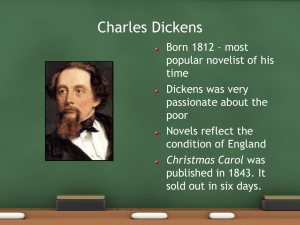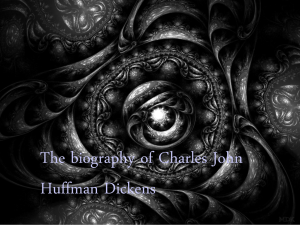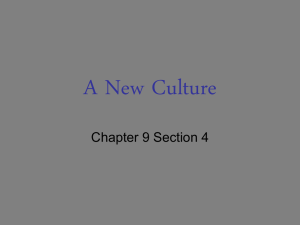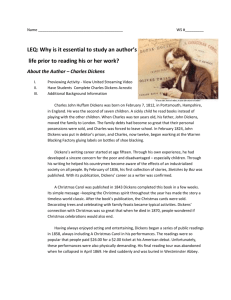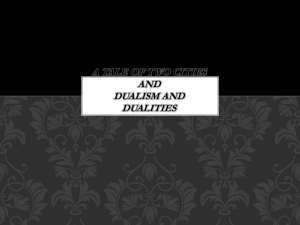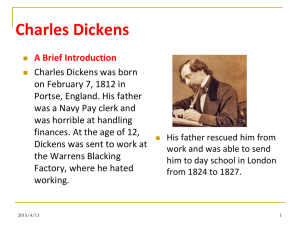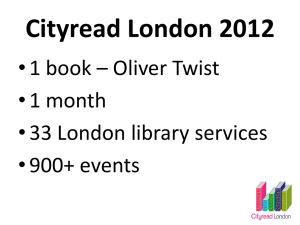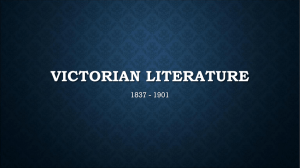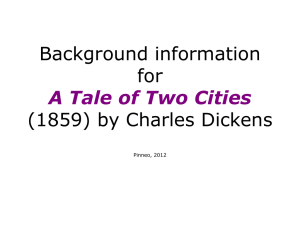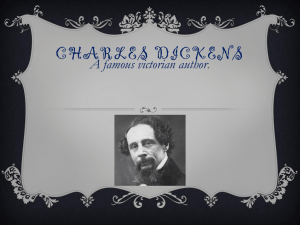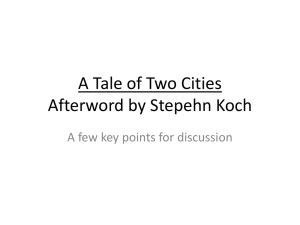Charles Dickens: his life and times
advertisement
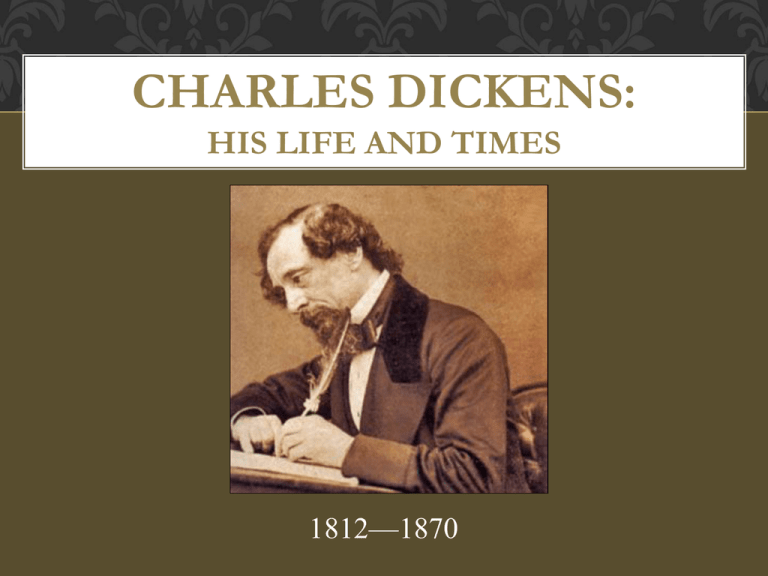
CHARLES DICKENS: HIS LIFE AND TIMES 1812—1870 CHILDHOOD Dickens’ father was a clerk who continually lived beyond his means. He went to debtor’s prison when young Charles was 12. Dickens’ mother and siblings were sent to debtor’s prison too, but not Charles… …He had to work in a boot-blacking factory and received 6 shillings a week to support his entire family. These experiences in Dickens’ youth directly influenced the development of themes in his writings such as abandonment, alienation, betrayal, and childhood poverty. A WRITING LIFE Dickens wrote 15 novels total as well as countless short stories and articles, including Great Expectations, Hard Times, David Copperfield, A Christmas Carol and Oliver Twist. Eventually, Charles became a day pupil at a school in London. At age 15 he got a job in a lawyer’s office as an office boy and learned shorthand. Dickens took various jobs as a reporter but after the success of the serial The Pickwick Papers (1837), he became a full-time novelist. In 1859, the year in which A Tale of Two Cities is published, Dickens was probably the most popular author of his time. DICKENS TRIVIA Dickens was married to Catherine Hogarth for 22 years, but separated from her around 1858. A Tale Of Two Cities is published in 1859. By this time Dickens is involved in a romance with Ellen Ternan, a young actress who is likely the model for the character of Lucie Manette. Dickens’ last book, The Mystery of Edwin Drood, was never finished. Dickens’ Contemporaries George Eliot Mark Twain William Thackery Anthony Trollope Thomas Hardy Emily Brontë Charlotte Brontë Rudyard Kipling Robert Louis Stevenson Arthur Conan Doyle Alfred, Lord Tennyson Robert Browning Elizabeth Barrett Browning Matthew Arnold George Meredith Gerard Manley Hopkins Dante Gabriel Rossetti Christina Rossetti VICTORIAN LITERATURE Education was spreading, and as literacy increased so did the impact of the written word. Probably at no other time before or since did books enjoy such enormous popularity and influence. ROMANTICISM — REALISM — NATURALISM Romanticism, the previous literary era (begins 1789), had begun as a radical departure from literary practice; now it was part of mainstream culture, and slightly stale. A new generation of writers, coming of age in a time of rapid technological change, began to examine the social effects of that change. Realism – a literary movement that presented life as it is, rather than as it might be. It sought to portray human life realistically, without the sugar coating or idealism of the previous era. Because it focused on these more downto-earth or prosaic events, the literature of realism is more suited to prose (poetry being the hallmark of the Romantics). Therefore, this shift in style helped make the Victorian Age the great age of the British novel. This literature appealed to a growing middle-class audience because of topics like family relationships, religion and morality, social change, and social reform. Naturalism – an outgrowth of realism that sought to apply the techniques of scientific observation to writing about life in the industrial age. Novels with details like the sour smells of poverty or the harsh sounds of factory life sought to expose injustice and promote social reform. They directly contradicted the romantic view of Nature as kindly and benevolent. The idea that nature mirrored human feelings was a “pathetic fallacy.” Naturalist writers portrayed nature as harsh and indifferent to the human suffering it often caused. ROMANTIC REVIVAL The Pre-Raphaelite Brotherhood – Formed about 1850, this group of painters and poets sought to ignore the ugliness of industrial life by portraying nature with the fidelity found in medieval Italian art before the Renaissance painter Raphael (1483-1520). The most famous artist/poet is of this movement is Dante Gabriel Rossetti. The Aesthetic Movement – These writers appeared at the tail end of the era, and turned away from the everyday world of realism. Instead, they sought to create “art for art’s sake” – works whose sole reason for being was their perfection or beauty. Oscar Wilde (We read him soon!) was at the forefront of this movement. It Was The Best of Times… Love New beginnings New purpose “Recalled to Life” It Was the Worst of Times… Social and economic inequality Terrible living conditions of the urban poor Arrogant and uncaring ruling class Industrial Revolution Hunger – Disease – Poverty – Ignorance Recipe for social upheaval A TALE OF TWO CITIES “The best story I have ever written.” Rich in detailed descriptions, offering a panoramic sweep of history, suspense, mystery, and terror. Based upon a massive 3-volume history of the French Revolution by Thomas Carlyle. The action takes place over a period of eighteen years, beginning in 1775 and ending in 1793. Some of the story takes place earlier, as told in a flashback. To Be Continued… A Tale of Two Cities, like all of Dickens’ novels, was published serially, or in weekly or monthly installments in popular magazines. The novel—Dickens’ twelfth—was published in the author’s new magazine, All the Year Round, from April to November 1859, and in book form the same year. A REAL CLIFFHANGER! The serial form allowed Dickens to introduce a large number of characters and develop the reader’s familiarity with them. It also allowed the author to respond to the likes and dislikes of the audience as he was writing the novel. Finally, serial publication required Dickens to end each installment with a “cliffhanger” to leave the audience in suspense, hungry for the next episode. As you read, pay attention to how Dickens ends each chapter. “Book the First: Recalled To Life” It was the best of times, it was the worst of times, it was the age of wisdom, it was the age of foolishness, it was the epoch of belief, it was the epoch of incredulity, it was the season of Light, it was the season of Darkness, it was the spring of hope, it was the winter of despair, we had everything before us, we had nothing before us, we were all going direct to heaven, we were all going direct the other way - in short, the period was so far like the present period, that some of its noisiest authorities insisted on its being received, for good or for evil, in the superlative degree of comparison only.
